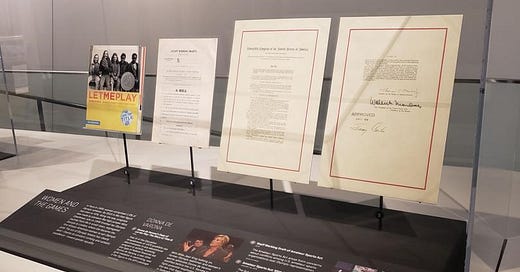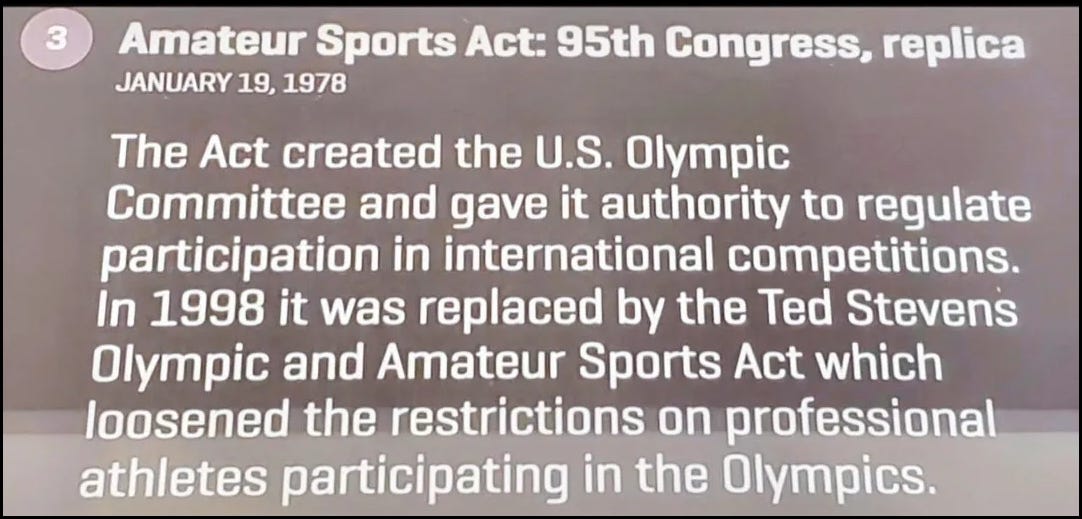This was a draft I submitted to The Fulcrum on March 27. However, eight days later, I requested that they not print it due to concerning news about the U.S. Center for SafeSport. I informed them that I needed to rewrite a new draft. I let you read the unpublished draft to help you better understand this law.
BIO: Deaflympian Howard Lee Gorrell was previously involved with the President's Commission on Olympic Sports and the legislative process of the Amateur Sports Act with U.S. Senator Ted Stevens of Alaska.
~~~~~~~~~~~~~~~~~~~~~~~~~~~~~~~~~~~~~~~~~
As a two-time Deaflympian and a member appointed by the U.S. Olympic Committee (USOC) to the USOC Handicapped in Sports Committee from 1979 to 1981, I visited the $96 million U.S. Olympic and Paralympic Museum (USOPM) in Colorado Springs for the first time on May 15, 2021. When I reached an artifact display case, I was struck by the profound historical significance of the two-sentence display of the Amateur Sports Act of 1978 (ASA). It was a moment that filled me with a deep sense of reverence for the history of our Olympic-related sports. So, I took a picture of it.
Fast forward to September 6, 2023, when Ed Williams, a former Chair of the USOC Athletes’ Advisory Council (1977-1981), testified before the Commission on the State of U.S. Olympics and Paralympics (CSUSOP) during a public hearing in Washington, D.C. He stated, “The USOC leadership, both staff and the board, must engage in a program of self-education. Just ask Mike Harrigan about that. Many good things and lessons learned in the past have been lost and forgotten on account of the lack of any institutional memory within the USOC.”
His reference to “Mike Harrigan” was not included in his pre-testimony, and he did not inform the Commission and C-SPAN about Harrigan's identity. However, several CSUSOP commissioners have always known who Harrigan is.
Michael “Mike” Harrigan went with me to this hearing, but the CSUSOP did not call him to testify.
Referring to the ASA display (shown in the image), this visual prompted the Colorado Springs Gazette to publish a detailed front-page article about the display's errors on January 30, 2022. These errors are significant because they misrepresent the historical context and the true spirit of the ASA, which is essential for understanding the governance of the U.S. Olympic and Paralympic Movement.
The ASA display begins with the statement, "The Act established the U.S. Olympic Committee [in 1978]." (Importantly, this statement has also been featured in various publications.)
The USOC was established in 1894 under the authority of the International Olympic Committee. In 1950, Congress granted a federal charter to the United States Olympic Association, which was renamed the United States Olympic Committee in 1961. The ASA amended the original 1950 charter. In 2019, the USOC officially changed its name to the United States Olympic & Paralympic Committee (USOPC).
Another error of the ASA display is that the Ted Stevens Olympic and Amateur Sports Act of 1998 did not replace the 1978 Act; it simply amended it. The Act also had nothing to do with changing eligibility standards for athletes participating in the Games.
The ASA designated the USOC as the coordinating body for amateur sports.
Thus, the 1978 Act represented a pivotal moment in sports history governance.
Harrigan is the former Executive Director of the President’s Commission on Olympic Sports from 1975 to 1977. This Commission sought to assess how sports in the United States could be structured to succeed in the Olympics and international competitions while promoting sports development in America. Their comprehensive 613-page report, divided into two volumes, established the foundation for the Amateur Sports Act of 1978.
In his 2018 opinion piece for the Sports Business Journal titled “No Need to Amend the Amateur Sports Act,” Harrigan noted that the underlying causes of the issues were mentioned by Williams and the Gazette article:
The USOC failed to properly oversee national governing bodies (NGBs) as the Amateur Sports Act required.
The USOC failed to understand certain portions of the ASA.
The USOC failed to educate its members and Congress on its contents.
The USOC's "culture" had ignored everything in its legislative mandate except the goal of winning Olympic medals.
Harrigan's conclusion underscores the crucial need for understanding and enforcing the Amateur Sports Act. He emphasized:
“First, the USOC and NGBs must know and follow the Act under which they operate. Second, the Committee must educate the Olympic community and Congress on the statute’s letter, spirit, and intent. Third, for USOC self-governance to thrive, Congress must regularly review how well such governance is being implemented. Fourth, the “culture” must change to reflect what the Act states. If these things are done, coupled with strong procedures to cover exposure, reporting, and action on sex abuse incidents, sex abuse problems should cease. There is no need to amend the Act; there is only a need to understand it and enforce it with congressional oversight conducted regularly.”
It is too late for Congress to respond to Harrigan’s 2018 requests.
In response to the Larry Nassar scandal, the U.S. Center for SafeSport, a vital entity in the U.S. Olympic and Paralympic Movement, was established under the Protecting Young Victims from Sexual Abuse and Safe Sport Authorization Act of 2017. Its mission to combat sexual misconduct and other forms of abuse is not only crucial but also reassuring to the public, ensuring the safety and integrity of our sports.
Unfortunately, the SafeSport Center encountered at least two significant issues last month, highlighting the pressing need for transparency and accountability in the governance of our sport.
The SafeSport Center hired an investigator with a history of sex crimes without conducting proper vetting. This prompted Sen. Chuck Grassley, R-Iowa, to send a letter on February 10 to the Center's CEO, giving her a month to respond to 13 questions regarding hiring former Allentown, PA, vice officer Jason Krasley.
On February 26, Judge John Woodard of the Seminole County (Fla.) Court ruled that the U.S. Center for SafeSport engaged in “fraud, collusion, pretense, and similar wrongdoing” in a 2022 case.
On March 4, the Athletes for Equity Resource Center, a group dedicated to promoting fairness and equality in sports, sent a letter titled "Dear Colleagues" to the U.S. Senate and House of Representatives regarding the Florida judicial order and the appointment of an investigator. The AERC informed Congress that the salary for the SafeSport Center’s CEO is $407,826, while the salaries for ten executives range from $169,893 to $215,426. (Note: The annual salary for a U.S. Congress member is $174,000.)
Returning to the ASA display, Harrigan and I were among the five USOPM's Ted Stevens Olympic and Amateur Sports Act working group members addressing these errors. Our list of requested corrections is on the desk of the new museum leadership, led by CEO Marisa Wigglesworth. Once given the opportunity, her dedicated staff will shape the development of an expanded ASA display and more, including oral history. After the changes are finalized, I will travel to Colorado to see them. Then, future museum visitors will finally understand the true meaning of the Amateur Sports Act.




